
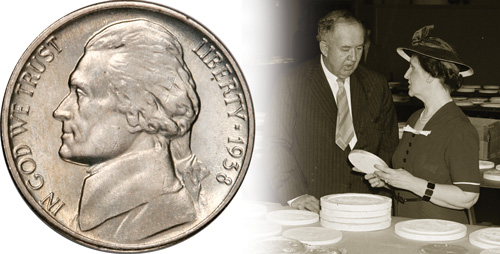
Edward Bruce and Mint Director Nellie Tayloe Ross inspect candidate designs
for the new Jefferson nickel in 1938.
Retracing the Route of the Jefferson Nickel
BY ED REITER
It's hard to imagine today, but at one time the Jefferson nickel was considered quite dramatic.
It was, in fact, part of what amounted to a coinage revolution – one that changed the face of Americans' pocket change from allegorical themes to portraits of national leaders. That artistic revolution was already under way with the cent and quarter, but the nickel tilted the balance and all but assured that the change would become complete.
![[photo: 1938 Jefferson Nickel]](/shop/api/assets/LCCCatalogAssetStore/images/content/featureimages/collectors-corner/retracing-the-route-of-the-jefferson-nickel/jefferson-portrait.jpg)
Thomas Jefferson penned the Declaration of Independence and served as 3rd U.S. President
Plans for a Jefferson nickel were hatched in 1937 by aides to President Franklin D. Roosevelt. FDR and fellow Democrats looked upon Thomas Jefferson as the founder of their party, and saw this as a chance to burnish his image and that of the party as well. It seemed logical, too, as a follow-up to the presidential portraits on the cent and quarter, both of which enjoyed wide popularity.
Under federal law, coin designs couldn't be changed until at least 25 years had elapsed since their introduction. Congressional approval was needed prior to that. Of the three remaining regular-issue coins (other than the cent and quarter), only the Buffalo nickel satisfied this requirement – and then just barely. Having made its debut in 1913, it was eligible for replacement in 1938.
The Buffalo nickel was – and still is – an enormously popular coin, viewed with affection by millions of Americans. From a technical standpoint, though, the coin had been a headache for the government right from the very beginning. Certain parts of the coin – notably the date – were high and exposed to wear, and by the 1930s dateless Buffalo nickels were becoming a real concern for the U.S. Mint.
[Schlag] originally showed a graceful side view, with a modernistic tree in the foreground – a rendition that has since won praise from many who have seen it.
For the new coin's design, the U.S. Treasury decided to use an outside artist, and held a public contest "open to all American sculptors." The winner would receive $1,000 – not a princely sum even then, but enough to get artists' attention at a time when the effects of the Depression were still being keenly felt. The contest's ground rules specified that the coin should bear "an authentic portrait" of Jefferson on the obverse and "a representation of Monticello," his famous Virginia home, on the reverse.
![[photo: 1938 Jefferson Nickel]](/shop/api/assets/LCCCatalogAssetStore/images/content/featureimages/collectors-corner/retracing-the-route-of-the-jefferson-nickel/1938-jefferson-nickel.jpg)
Felix Schlag's Jefferson nickel first rolled off mint presses in 1938. This design would remain largely unchanged for 65 years – until the Westward Journey series of 2004‑2006.
By the deadline of April 15, 1938, the Treasury had received 390 entries. Of these, the judges narrowed the list, finally settling upon an entry from Felix Schlag, a Chicago sculptor born in Germany who had come to the United States only nine years earlier.
Even though it was the judges' choice, Schlag's design still had to run a gauntlet of further critics, including the federal Commission of Fine Arts. During this review process, several modifications were recommended, and Schlag was asked to revise his models in ways both subtle and substantial.
The most important change involved the artist's depiction of Monticello. He originally showed a graceful side view, with a modernistic tree in the foreground – a rendition that has since won praise from many who have seen it. At the insistence of the Fine Arts Commission, he substituted it with the straight-on frontal view that ended up appearing on the coin – one which cynics have likened to a mausoleum. He also softened Jefferson's jutting jaw and made the lettering more traditional.
Unlike many artists who have fashioned U.S. coins, Schlag did not initially receive credit for his design on the coin itself. His initials were not added until 1966 – below Jefferson's bust – where they remained until 2004 (the one-year 2005 obverse and new front-facing obverse of 2006 to date bear the initials of their own engravers or designers).
Production of 1938 Jefferson nickels didn't begin until October, and the first examples weren't issued until Nov. 15. In the meantime, to meet a modest demand for fivecent pieces, the Denver Mint had struck 7.2 million Buffalo nickels – the only ones made in that series' final year. Partly because of the late start, output of Jefferson nickels was modest in 1938, particularly at the Denver and San Francisco branch mints. The coins are quite affordable, however, even in mint condition, because so many were set aside at the time.
![[photo: 1938 Jefferson Nickel]](/shop/api/assets/LCCCatalogAssetStore/images/content/featureimages/collectors-corner/retracing-the-route-of-the-jefferson-nickel/1945-jefferson-nickel.jpg)
The composition of the Jefferson nickel changed during World War II to save needed metals for the war effort. These "Wartime nickels" are easily identified by a large mint mark on the reverse above Monticello.
Since its introduction over 60 years ago, the Jefferson nickel has undergone very few changes. Its composition was changed during World War II in order to conserve copper and nickel, which were urgently needed for warrelated purposes. Other than that, however, it has featured a composition throughout its long run, of 75% copper and 25% nickel. (The "wartime nickels" of 1942-1945 were 56% copper, 35% silver and 9% manganese. These nickels can easily be identified by a large mint mark on the reverse above Monticello.) In spite of the composition changes, the basic design remained the same through 2003. In the same 65-year period, every other circulating U.S. coin saw either a design change, a new composition, or both.
Fast-forward to the 21st century. A decade ago, the United States Mint was making preparations for special Jefferson nickels marking the 200th anniversary of the trailblazing Lewis and Clark Expedition. Four such nickels were issued in 2004 and 2005, and today they turn up with some regularity in Americans' pocket change.
Now, the Jefferson nickel finds itself on a different kind of journey – one that could end with the elimination of the five-cent piece from the nation's circulating coinage. If that happens, the Lewis and Clark coins – sometimes called the "Westward Journey" nickels – will end up in a wilderness from which their return is unlikely.
Now, the Jefferson nickel finds itself on a different kind of journey – one that could end with the elimination of the five-cent piece from the nation's circulating coinage.
The obstacles that confronted U.S. Army Captains Meriwether Lewis and William Clark two centuries ago were physical. Their mission – given to them directly by President Thomas Jefferson – was to explore the vast territory of the Louisiana Purchase after the United States acquired the largely virgin land mass from France in 1803. By contrast, the challenges that cloud the future of the five-cent piece today are economic. Because of sharp rises in the value of the coin's component metals, it now costs Uncle Sam upwards of 11 cents – more than twice face value – to make each nickel. With nearly a billion produced in 2011 alone, American taxpayers lost $56.5 million in the last fiscal year.
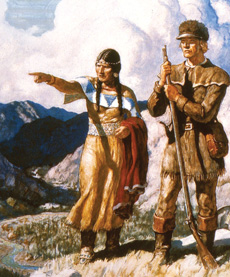
Authorized by Thomas Jefferson, Lewis and Clark's amazing journey explored the vast territory of the Louisiana Purchase. Sacagawea accompanied the group, serving as a guide and interpreter.
This situation is similar to that of the Lincoln cent. Every new "penny" struck by the mint in 2011 cost the federal government 2.4 cents for material, labor and distribution. And recently, cents have been made by the billions – in fact, nearly 5 billion were minted in 2011 alone, resulting in a net loss of tens of millions of dollars.
The mint has been testing potential new compositions for both the nickel and the cent (which is made almost entirely from zinc and gets its reddish color from a copper plating). They were authorized to explore alternatives by the Coin Modernization, Oversight and Continuity Act of 2010. As of mid-2012, no alternatives had been chosen and the tests were continuing. The legislation not only authorizes examination of new compositions for the cent and nickel, but also allows the Mint to study alternative metals for other circulating coin denominations.
Aluminum and steel are among the metals that have been proposed for the fivecent piece. Other suggested alternatives are to reduce the nickel content, or make the coin smaller. It wouldn't be easy to come up with an attractive new metallic composition for the coin, since costs have risen for all other base metals, too.
Eliminating the cent and the nickel denominations entirely might seem extreme to some Americans, but similar steps already have been taken by more than a dozen other nations, including Israel, Switzerland and Brazil. Canada stopped making cents in April 2012, and is now reportedly sharpening the ax for five-cent pieces as well.
Eliminating the cent and nickel denominations entirely might seem extreme to some Americans, but similar steps already have been taken by more than a dozen other nations...
The U.S. cent and nickel were facing no such threat when Congress passed the American 5-Cent Coin Design Continuity Act of 2003. At that time, it cost the government just 3.46 cents apiece to produce and distribute nickels. The cost of minting cents was 0.98 cent apiece – a razor-thin profit margin, but still in the black.
The big news then was that after 65 years, the nickel would finally be getting a makeover – at least temporarily. The 2003 legislation authorized the mint to redesign both sides of the nickel to commemorate the bicentennial of both the Louisiana Purchase and the Lewis and Clark Expedition. It also stipulated that beginning in 2006, the likeness of Thomas Jefferson – the president who set both events in motion – must appear on the obverse of the coin. His stately Virginia home, Monticello, would also be featured on the reverse once again.
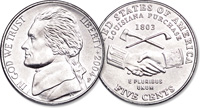
Recalling the original peace medals given as tokens of friendship to Native Americans during the Lewis & Clark Expedition, this design marked the start to the Westward Journey series.
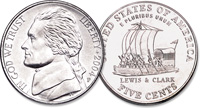
This second Westward Journey nickel design honored the 55-foot keelboat used on the voyage to navigate the Missouri River and beyond.

Continuing the tribute to the Lewis & Clark expedition, this new design was the first with a new obverse portrait. The reverse honored the wildlife encountered on the trek – like the massive buffalo, which had great significance to the Native Americans.
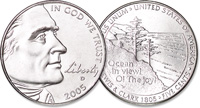
On November 7, 1805 Captain William Clark excitedly penned in his journal, "Ocean in view! O! The joy!" After 18 months of paddling rivers, riding rapids, portaging gear and crossing the Continental Divide, Lewis & Clark had reached the Pacific Ocean.
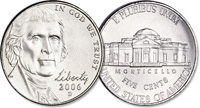
Featuring a new, forward-facing portrait of Jefferson, the 2006 Return to Monticello nickel signified both the return of the Lewis & Clark expedition, and the return of the Monticello design to the reverse.
Under this authority, the mint issued two special nickels in 2004 and two more in 2005 – each with a new design on the reverse. In 2004, the first of these bore an adaptation of the Indian Peace Medal struck for presentation to tribal chiefs during Jefferson's presidency, while the second depicted a keelboat used by the Lewis and Clark Expedition. The first 2005 coin portrayed an American bison, one of the many native animals encountered by the explorers; the second showed the Pacific coastline along with the inscription "Ocean in view! O! The Joy!" – an entry from a journal kept by William Clark, co-leader of the expedition. The 2004 nickels carried the same likeness of Jefferson as previous coins in the series. In 2005 the portrait changed to a right-facing profile blending into the rim, with the word "Liberty" shown in script based upon Jefferson's handwriting. Yet another new portrait of Jefferson was introduced in 2006, this time in a full-face view. This obverse design has graced the nickel ever since, along with the original depiction of Monticello on the reverse.
Westward Journey nickels were produced in somewhat larger quantities than those of most other recent years. But that was to be expected, since two different nickels were being struck each year at both the Philadelphia and Denver Mints. (The San Francisco Mint only made Proofs.)
Until these special issues came along, the series had lagged behind other modern issues in terms of hobby activity – in part because of the sameness of its appearance. The Westward Journey coins were like a breath of fresh air to the Jefferson nickel... But now, less than a decade later, the Jefferson series faces an ominous new fork in the road as it nears the ripe old age of 75.
This time, the stakes are higher... for waiting down one of those two divergent paths is the end of the trail.

